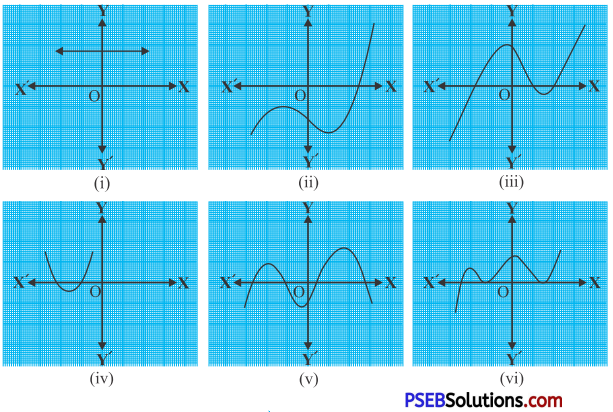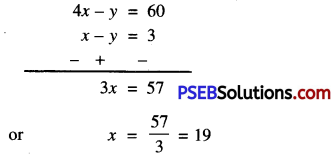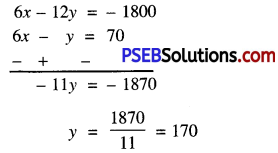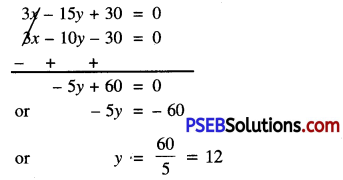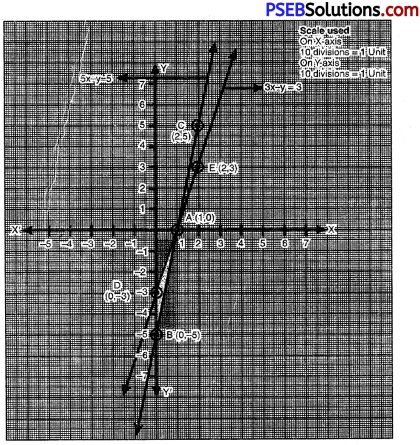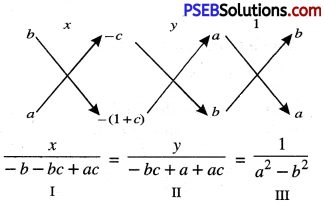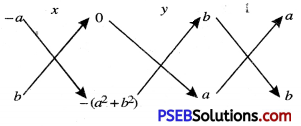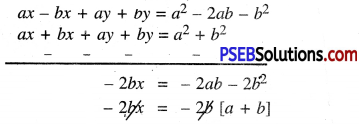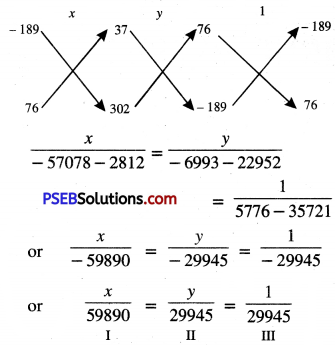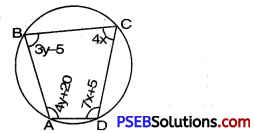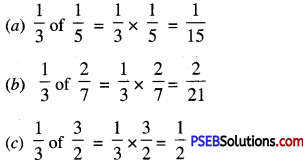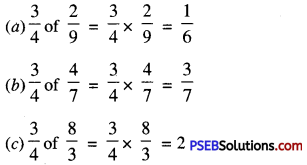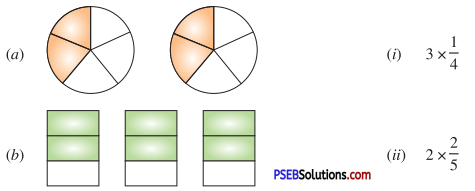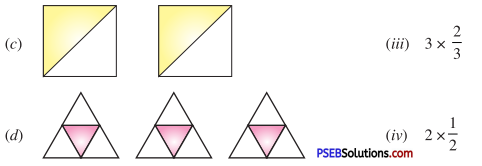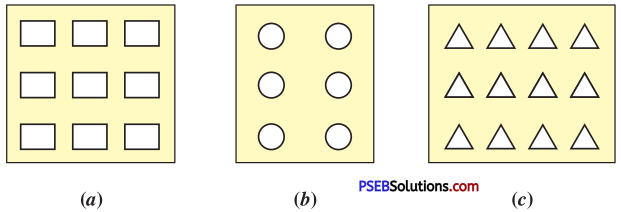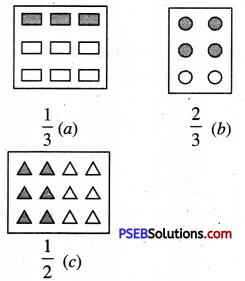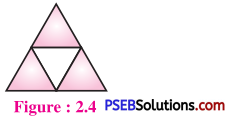Punjab State Board PSEB 10th Class Maths Book Solutions Chapter 1 Real Numbers Ex 1.4 Textbook Exercise Questions and Answers.
PSEB Solutions for Class 10 Maths Chapter 1 Real Numbers Ex 1.4
Question 1.
Without actually performing the long division, state whether the following rational numbers will have a terminating decimal expansion or a non-terminating repeating decimal expansion :
(i) \(\frac{13}{3125}\)
(ii) \(\frac{17}{8}\)
(iii) \(\frac{64}{455}\)
(iv) \(\frac{15}{1600}\)
(v) \(\frac{29}{343}\)
(vi) \(\frac{23}{2^{3} 5^{2}}\)
(vii) \(\frac{129}{2^{5} 5^{7} 7^{5}}\)
(viii) \(\frac{6}{15}\)
(ix) \(\frac{35}{50}\)
(x) \(\frac{77}{210}\)
Solution:
(i)Let x = \(\frac{13}{3125}\) ………..(1)
Compare (1) with x = \(\frac{p}{q}\)
Here p = 13 and q = 3125
Prime factors of q = 3125 = 5 × 5 × 5 × 5 × 5 = 55 × 20
which are of the form 2n × 5m here n = 0, m = 5
which are non negative integers.
∴ x = \(\frac{13}{3125}\) have a terminating decimal expansion.

(ii) Let x = \(\frac{17}{8}\) …………………(1)
Compare (1) with x = \(\frac{p}{q}\)
Here p = 17 and q = 8
Prime factors of q = 8 = 2 × 2 × 2 = 23 = 23 × 50
which are of the form 2n × 5m here n = 3, m = 0
and these are non negative integers.
∴ x = \(\frac{17}{8}\) have a terminating decimal expansion.
(iii) Let x = \(\frac{64}{455}\) …………(1)
Compare (1) with x = \(\frac{p}{q}\)
Here p = 64, q = 455
Prime factors of q = 455 = 5 × 7 × 13 which are not of the form 2n × 5m
∴ x = \(\frac{64}{455}\) has a non – terminating decimal expansion.

(iv) Let x = \(\frac{15}{1600}\) ……….(1)
Compare (1) with x = \(\frac{p}{q}\)
Here p = 15 and q = 1600
Prime factors of q = 1600
= 2 × 2 × 2 × 2 × 2 × 2 × 5 × 5 = 26 × 52
which are of the form 2n × 5m, here n = 6, m = 2 and these are non negative integers.
∴ x = having terminating decimal expansion.
(v) Let x = \(\frac{29}{343}\) ………… (1)
Compare (1) with x = \(\frac{p}{q}\)
Here p = 29 and q = 343
prime factors of q = 343
= 7 × 7 × 7 = 73
which are not of the form 2n × 5m, here n = 0, m = 0
∴ x = \(\frac{29}{343}\) will have a non – terminating decimal expansion.
(vi) Let x = \(\frac{23}{2^{3} 5^{2}}\) ……….(1)
Compare (1) with x = \(\frac{p}{q}\)
Here p = 23, q = 2352
Prime factors of q = 2352
which are of the form 2n × 5m, here n = 3, m = 2 and these are non negative integers.
∴ x = \(\frac{23}{2^{3} 5^{2}}\) will have a terminating decimal expansion.
(vii) Let x = \(\frac{129}{2^{5} 5^{7} 7^{5}}\) ……………….(1)
Compare (1) with x = \(\frac{p}{q}\)
Here p = 129 and q = 25 57 75
Prime factors of q = 25 57 75
which are not of the form 2n × 5m,
∴ x = \(\frac{129}{2^{5} 5^{7} 7^{5}}\) have a non – terminating decimal expansion.

(ix) Let x = \(\frac{35}{50}=\frac{7}{10}\) …………. (1)
Compare (1) with x = \(\frac{p}{q}\)
Here p = 7, q = 10
Prime factors of q = 10 = 2 × 5 = 21 × 51
Which is of the form 2n × 5m here n = 1, m = 1
both n and m are non negative integer.
∴ x = \(\frac{35}{50}\) have a terminating decimal expansion.
(x) Let x = \(\frac{77}{210}=\frac{11}{30}\) ……………..(1)
Compare (1) with x = \(\frac{p}{q}\)
Here p = 11, q = 30
Prime factors of q = 30 = 2 × 5 × 3
which are not of the form 2n × 5m,
∴ x = \(\frac{77}{210}\) have a non – terminating decimal expansion.

Question 2.
Write down the decimal expansions of those rational numbers in Question 1 above which have terminating decimal expansions.
Solution:
(i) Let x = \(\frac{13}{3125}\)
Compare (1) with x = \(\frac{p}{q}\)
Here p = 13,q = 3125
Prime factors of q = 3125 = 5 × 5 × 5 × 5 × 5 = 55 × 20
Which are of the form 2n × 5m, where n = 0, m = 5 and these are non negative integers
∴ x = have a terminating decimal expansion.
To Express in Decimal form
x = \(\frac{13}{3125}=\frac{13}{5^{5} \times 2^{0}}\)
x = \(\frac{13 \times 2^{5}}{5^{5} \times 2^{5}}\)
[∵ we are to make 10 in the denominator so multiply and divide by 25]
x = \(\frac{13 \times 32}{(2 \times 5)^{5}}\)
x = \(\frac{416}{(10)^{5}}=\frac{416}{100000}\)
x = 0.00416
(ii) Let x = \(\frac{17}{8}\) ………………..(1)
Compare (1) with x = \(\frac{p}{q}\)
Here p = 17, q = 8
Prime factors of q = 8 = 2 × 2 × 2 = 23 × 50
Which are of the form 2n × 5m, where n = 3, m = 0 and these are non negative integers
∴ x = \(\frac{17}{8}\) can be expressed as a terminating decimal expansion.
To Express in Decimal form
x = \(\frac{17}{8}=\frac{17}{2^{3} \times 5^{0}}\)
x = \(\frac{17 \times 5^{3}}{2^{3} \times 5^{3}}\)
[Multiply and divide with 53 to make the denominator 10]
x = \(\frac{17 \times 125}{(2 \times 5)^{3}}\)
x = \(\frac{2125}{(10)^{3}}=\frac{2125}{1000}\)
x = 2.125
⇒ \(\frac{17}{8}\) = 2.125

(iii) Let x = \(\frac{15}{1600}\) …………….(1)
Compare (1) with x = \(\frac{p}{q}\)
Here p = 15, q = 1600
Prime factors of q = 1600
= 2 × 2 × 2 × 2 × 2 × 2 × 5 × 5
= 26 × 52
Which are of the form 2n × 5m, where n = 6, m = 2 and these are non negative integers
∴ x = \(\frac{15}{1600}\) can be expressed as a terminating decimal expansion.
To Express in Decimal form
x = \(\frac{15}{1600}\)
x = \(\frac{15 \times 5^{4}}{2^{6} \times 5^{2} \times 5^{4}}\)
[To make denominator a power of 10 multiply and divide by 54]
x = \(\frac{15 \times 625}{2^{6} \times 5^{6}}\)
x = \(\frac{9375}{(2 \times 5)^{6}}\)
x = \(\frac{9375}{(10)^{6}}=\frac{9375}{1000000}\) = 0.009375
In Decimal form, x = \(\frac{15}{1600}\) = 0.009375
(iv) Let x = \(\frac{23}{2^{3} 5^{2}}\) …………….(1)
Compare (1) with x = \(\frac{p}{q}\)
Here p = 15, q = 23 52
Prime factors of q = 23 52
Which are of the form 2n × 5m, where n = 3, m = 2 and these are non negative integers
∴ x = \(\frac{23}{2^{3} 5^{2}}\) have a terminating decimal expansion.
To Express in Decimal form
x = \(\frac{23}{2^{3} 5^{2}}=\frac{23 \times 5}{2^{3} \times 5^{2} \times 5}=\frac{115}{2^{3} \times 5^{3}}\)
x = \(\frac{115}{(2 \times 5)^{3}}=\frac{115}{1000}\) = 0.115
In Decimal form,
x = \(\frac{23}{2^{3} 5^{2}}\) = 0.115

(v) Let x = \(\frac{6}{15}=\frac{2}{5}\)
Compare (1) with x = \(\frac{p}{q}\)
Here p = 2, q = 5
Prime factors of q = 5 = 20 × 51
Which are of the form 2n × 5m, where n = 0, m = 1 and these are non negative integers
∴ x = \(\frac{6}{15}\) have a terminating decimal expansion.
To Express in Decimal form
x = \(\frac{6}{15}=\frac{2}{5}\)
x = \(\frac{2 \times 2^{1}}{2^{1} \times 5^{1}}=\frac{4}{10}\) = 0.4
In Decimal form,
x = \(\frac{6}{15}\) = 0.4
(vi) Let x = \(\frac{35}{50}=\frac{7}{10}\)
Compare (1) with x = \(\frac{p}{q}\)
Here p = 7, q = 10
Prime factors of q = 5 = 21 × 51
Which are of the form 2n × 5m, where n = 1, m = 1 and these are non negative integers
∴ x = \(\frac{7}{10}\) have a terminating decimal expansion.
To Express in Decimal form
x = \(\frac{35}{50}\)
x = \(\frac{7}{10}\)
x = \(\frac{7}{2^{1} \times 5^{1}}\)
x = \(\frac{7}{(2 \times 5)^{1}}=\frac{7}{(10)^{1}}\) = 0.7
Hence in decimal form, x = 0.7

Question 3.
The following real numbers have decimal expansions as given below. In each case, decide whether they are rational or not. If they are rational, and of the form f, what can you say about the prime factors of q?
(i) 43.123456789
(ii) O.120120012000120000……
(iii) 4.3.123456789
Solution:
(i) Let x= 43.123456789 ……….. (1)
It is clear from the number that x is rational number.
Now remove the decimal from the number
∴ x = \(\frac{43123456789}{1000000000}\)
= \(\frac{43123456789}{10^{9}}\) …………….(2)
From (2) x is a rational number and of the \(\frac{p}{q}\).
Where p = 43123456789 and q = 109
Now, Prime factors of q = 100 = (2 × 5)9
⇒ Prime factors of q are 29 × 59

(ii) Let x = 0.120120012000120000
It is clear from the number that it is an irrational number.
(iii) Let x = 43.123456789 …. (1)
It is clear that the given number is a rational number because it is non-terminating and repeating decimal.
To show that (i) is of the form \(\frac{p}{q}\)
Multiply (1) with 109 on both sides,
109 x = 43123456789.123456789 …………….(2)
Subtract (1) from (2), we get:
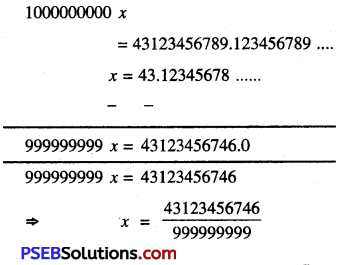
which is rational number of the form \(\frac{p}{q}\)
x = \(\frac{4791495194}{111111111}\)
Here p = 4791495194, q = 111111111
x = \(\frac{4791495194}{3^{2}(12345679)}\)
Hence, prime factors of q are 32 (123456789)
